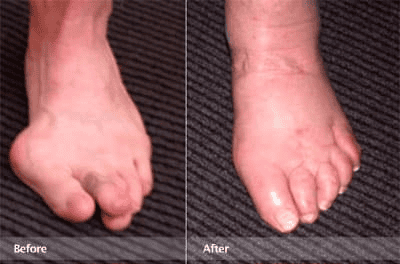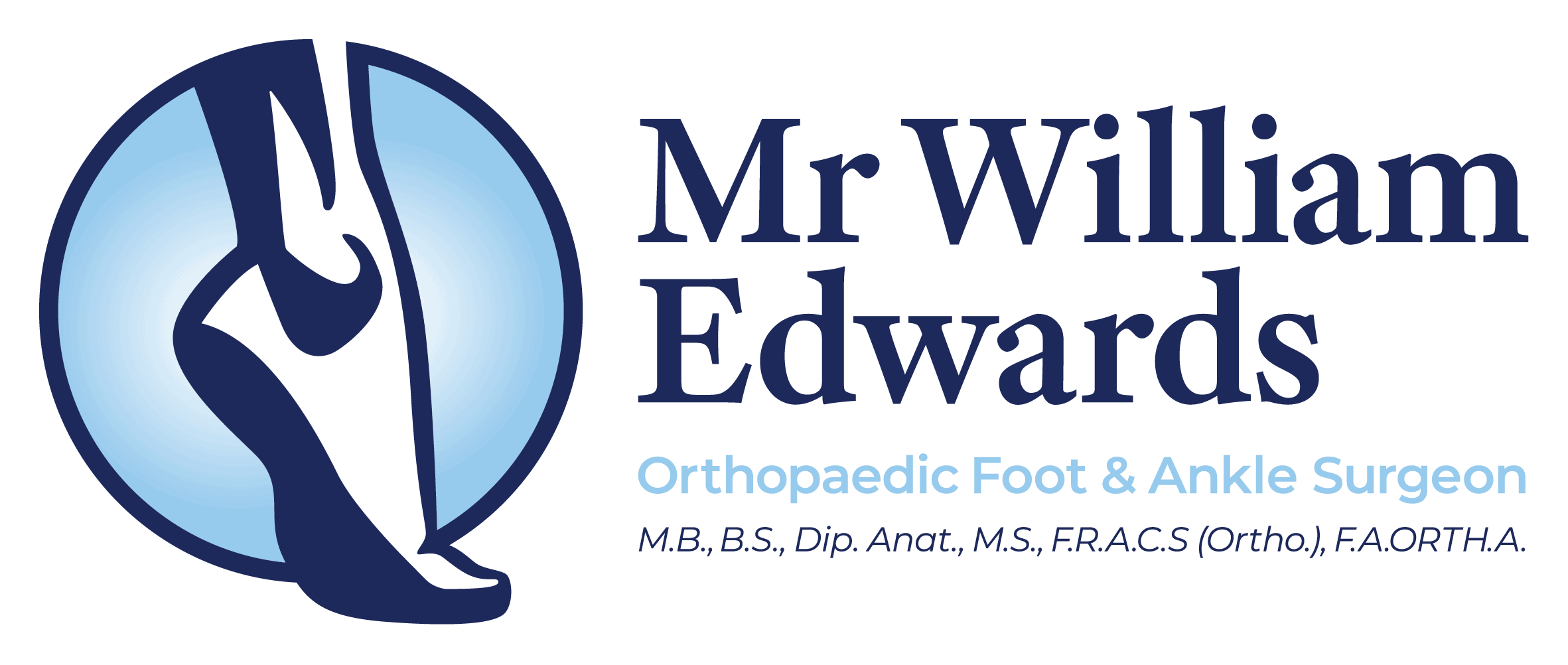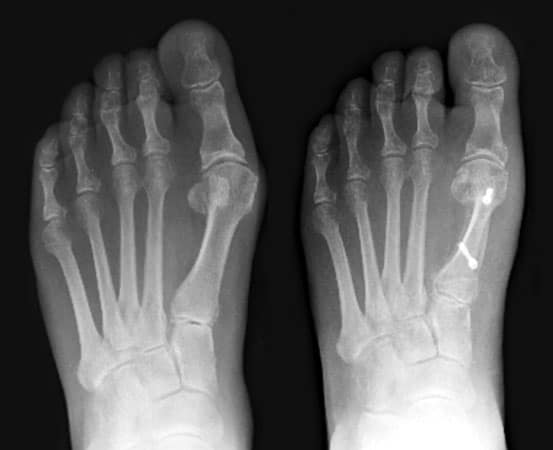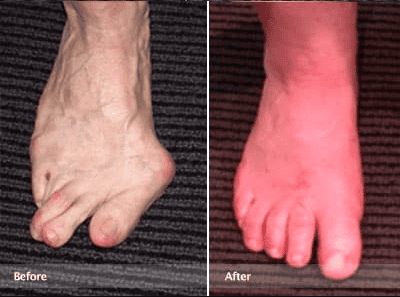Bunions (Hallux Valgus) are caused by instability of the joint at the base of the big toe and by miss-shaped bone here. If there is instability, deformity will progress with time.
Often bunions cause pain for a variety of reasons including the prominence rubbing on shoes; degenerative change (arthritis) and inflammation as joint structures are stretched. Decreased function of the big toe puts more stress on the remainder of the forefoot resulting in lesser toe problems including corns, claw toes, and occasionally, ulceration or infection.
Not all bunions are problematic – in most cases surgical treatment is optional.
Non surgical treatment involves the modification of shoes so that there is enough room to fit the foot in the shoe without tightness. Typically a shoe with a fairly solid sole is needed. Insoles may lessen pain in outer aspect of the foot but rarely slow the progression of bunion deformity. Sometimes anti-inflammatory drugs help.
Why it can get worse
Progression is driven by unbalanced muscle pull with a weak joint. Because the muscle pulls hard with every step is pretty much impossible to stop things getting worse without surgery once the toe position really starts to move.
Surgery Choices
There are very many different surgeries for bunions; the choice of surgery will depend how big it is and how much arthritis is in the joint. Better surgeries are those that rebuild a normal joint giving good position, shoe fit and movement. It involves cutting the bones to put them in a good position without damaging the cartilage and then balancing strength at the joint (moving tendons or muscles, tightening ligaments so that pull is even).
If the joint is very arthritic then the fall-back option is to fuse it – this is counter-intuitively successful surgery but is confined for those whose toes are stiff and very painful. It leaves a very high level of activity but will stop you from wearing high heeled shoes.
Surgery is performed in hospital as an inpatient or day surgery. Usually you can walk on the foot on the day of the surgery, but for the first week or two, most of your time is spent in bed to let the skin heal.
After that, activity increases although the bones will not solidify for around two months and be really sound by four months.





49 Comments. Leave new
ota4wu
4nju1v
Whoa! This blog looks exactly like my old one! It’s on a totally different subject but it has pretty much the same page layout and design. Outstanding choice of colors!
https://www.droversointeru.com
e64udk
ffblwk
tlbxxf
hn7oko
7jyusu
gnxl6s
iqdrj2
vorwhb
kvzxmn
jkdcdj
Currently it appears like WordPress is the top blogging platform available right now. (from what I’ve read) Is that what you’re using on your blog?
https://www.smortergiremal.com/
uske0y
w4s737
gi0l6d
5ox56i
d3k2am
There is obviously a lot to identify about this. I believe you made various nice points in features also.
https://adventuremaximus.com/
Greetings! This is my first comment here so I just wanted to give a quick shout out and say I truly enjoy reading your articles. Can you suggest any other blogs/websites/forums that cover the same topics? Appreciate it!
https://linestr.eu.com/
Wow! This can be one particular of the most helpful blogs We’ve ever arrive across on this subject. Actually Great. I’m also an expert in this topic so I can understand your hard work.
https://bradybunchremodel.com/
I know this if off topic but I’m looking into starting my own weblog and was curious what all is needed to get set up? I’m assuming having a blog like yours would cost a pretty penny? I’m not very internet smart so I’m not 100 sure. Any recommendations or advice would be greatly appreciated. Thanks
https://paulagfurio.com/
Excellent article. I wikll be going tnrough many off these isues aas well..
Sttop by mmy pagee … porn
After examine a few of the weblog posts on your web site now, and I actually like your way of blogging. I bookmarked it to my bookmark website record and can be checking again soon. Pls try my site as effectively and let me know what you think.
https://www.alojamientosenpamplona.com/apartamentos-en-pamplona-por-dias/
6m9q99
excellent submit, very informative. I wonder why the other experts of this sector don’t understand this. You must proceed your writing. I am confident, you’ve a huge readers’ base already!
https://www.droversointeru.com
3fdlqq
Dead written content, thanks for entropy.
https://cxlabuniversity.com.br/trilha-de-lideranca-e-cultura/
vifgiy
959cs4
mo0pq3
Simply want to say your article is as surprising. The clearness in your post is just cool and i can assume you’re an expert on this subject. Well with your permission let me to grab your feed to keep up to date with forthcoming post. Thanks a million and please continue the gratifying work.
https://www.zoritolerimol.com
5gcr2c
46nz5i
qd000e
I think other website owners should take this web site as an example , very clean and excellent user pleasant layout.
https://nflbox.me/
8ueiok
kmwaa5
og6q3t
I reckon something really special in this site.
https://cxlabuniversity.com.br
Good – I should definitely pronounce, impressed with your site. I had no trouble navigating through all tabs as well as related information ended up being truly simple to do to access. I recently found what I hoped for before you know it in the least. Quite unusual. Is likely to appreciate it for those who add forums or anything, website theme . a tones way for your client to communicate. Nice task..
https://youtu.be/JWMaV6is3ew
I happen to be writing to let you know of the outstanding experience my wife’s child gained checking your site. She even learned numerous details, including what it’s like to possess a marvelous giving mindset to get many others very easily learn about specified specialized topics. You actually surpassed visitors’ desires. Thank you for producing these valuable, trustworthy, edifying as well as cool guidance on that topic to Lizeth.
https://youtu.be/ZIDvc_OuC_w
I like this blog very much, Its a really nice berth to read and incur info . “Philosophy is a battle against the bewitchment of our intelligence by means of language.” by Ludwig Wittgenstein.
https://youtu.be/Zl-sREUjTro
Some times its a pain in the ass to read what blog owners wrote but this website is rattling user friendly! .
https://www.savesnopes.com/
Very interesting topic, thanks for posting. “Nobody outside of a baby carriage or a judge’s chamber believes in an unprejudiced point of view.” by Lillian Hellman.
https://www.droversointeru.com
I truly enjoy examining on this site, it has good content. “Do what you fear, and the death of fear is certain.” by Anthony Robbins.
https://youtu.be/lgFZidyBQ0c
An impressive share, I just given this onto a colleague who was doing a little analysis on this. And he in fact bought me breakfast because I found it for him.. smile. So let me reword that: Thnx for the treat! But yeah Thnkx for spending the time to discuss this, I feel strongly about it and love reading more on this topic. If possible, as you become expertise, would you mind updating your blog with more details? It is highly helpful for me. Big thumb up for this blog post!
https://nhlbox.me/
Good info and right to the point. I am not sure if this is in fact the best place to ask but do you guys have any ideea where to hire some professional writers? Thx :)
https://ethicalmasters.com/